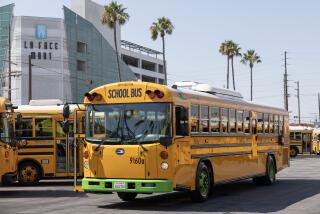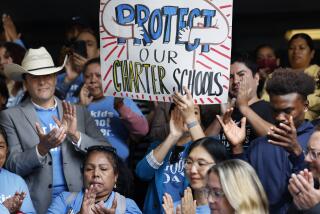Letting Schools Out for Summer
New Los Angeles schools Supt. Roy Romer said this week that he intends to reverse two decades of reliance on year-round scheduling and busing as substitutes for building schools and that he is considering a massive program to lease commercial space to house students quickly.
In an interview on the district’s daunting classroom shortage, Romer said he is not satisfied with current school construction plans, which would add 65,000 seats in three to six years.
“Now, that takes too long,” Romer said. “We need help sooner. So I’m also really trying to push on fast forward what can we lease in the meantime.”
He also said his goal is to begin scaling back the use of the multitrack calendar that effectively adds 50% to a school’s capacity by keeping students on campus all year in shortened, overlapping terms.
About a third of the district’s schools have year-round calendars, including 18 of 49 high schools. The district’s construction plan would provide just enough seats for anticipated enrollment growth only if every senior high converts to a year-round schedule in the next six years.
Romer said he is also struggling to come up with a closure strategy for the Belmont Learning Complex, which continues to stir controversy despite the board’s January vote to abandon the unfinished downtown high school because of environmental and safety concerns.
Pressure from politicians and community groups to resume construction has mounted as district officials have met opposition to every site proposed as a replacement.
Despite rumors that he might try to revive the project, Romer said he is working within the board’s policy while looking for a use for the site that can unite factions.
But he said he believes it would be useful to complete environmental studies that the district suspended after the January vote.
“I am raising the question that you still have a final act to dispose of this property or use it for something,” he said. “I am suggesting an environmental study will help in that decision.”
After discussing the project with him behind closed doors Thursday, the board authorized Romer to return in a month with a proposal for an environmental study looking at various nonclassroom options for the property, board President Genethia Hayes said.
Romer said he has made Belmont a high priority because it threatens to poison the climate for other school-building initiatives.
“In order to get this done, we need a community that’s unified as much as possible,” he said. “When you’ve got an issue like Belmont out there, it tends to make us go to war.”
Romer acknowledged that it’s unrealistic to expect that he can come up with enough classrooms to restore the traditional two-semester system at all schools during his administration.
“I don’t want to put that out as something that’s going to be accomplished while I’m here,” he said. “But I’d like to diminish” the number of schools on year-round schedules.
He said the harms of the multitrack system, coupled with extensive busing of students out of crowded schools, are too great for him to ignore.
“It’s not just a matter of having a place for kids to be,” he said. “It’s the amount of time spent on buses, the shortness of the school year, teachers moving from class to class, taking all their stuff out of the room because another teacher is coming, and no place to house those you are retaining,” he said. “You hold a kid out because of no social promotion, and you don’t have a place to put them for summer school--you’re in trouble.”
Romer said he is exploring a variety of options for delivering instruction, including different ways of scheduling and the creation of “virtual” electronic classrooms.
He also said he would consider employing California’s charter school law as part of the effort to open new classrooms. Because charter schools are exempt from most provisions of the state Education Code, they are free to open in privately leased buildings that otherwise might not comply with the state’s stringent school earthquake safety law.
While he will consider recommending amendments to that law, called the Field Act, to facilitate the use of commercial space, Romer said the safety of children remains paramount.
His major initiative will be to locate buildings that can be adapted to meet the state’s seismic requirements for schools, which are tougher than those for other public and private structures.
“I grabbed the Field Act and I have an engineer out there combing this town right now, saying, ‘Show me buildings that we can make safe for children,’ ” he said.
Besides office buildings, Romer said, he is looking for large-span buildings such as supermarkets.
“Say a Safeway supermarket,” he said. “You’re able to use something like that for education purposes, but you may have to go in and put in additional struts and spans to meet code.”
More to Read
Sign up for Essential California
The most important California stories and recommendations in your inbox every morning.
You may occasionally receive promotional content from the Los Angeles Times.











